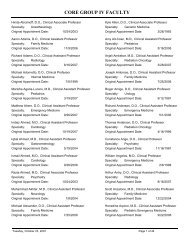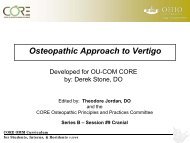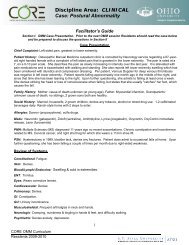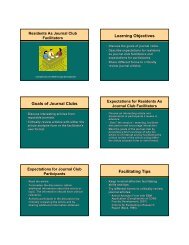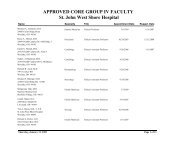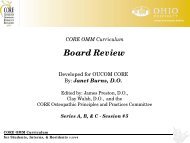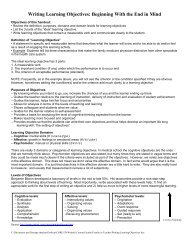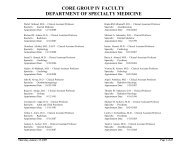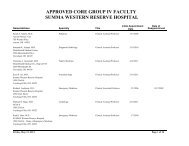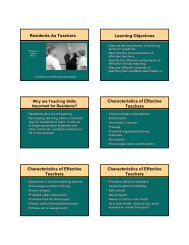Clinical Case: Chronic Pancreatitis
Clinical Case: Chronic Pancreatitis
Clinical Case: Chronic Pancreatitis
You also want an ePaper? Increase the reach of your titles
YUMPU automatically turns print PDFs into web optimized ePapers that Google loves.
Discipline: <strong>Clinical</strong><br />
<strong>Case</strong>: <strong>Chronic</strong> <strong>Pancreatitis</strong><br />
8. What are the acute or chronic aspects? Acute – pain<br />
<strong>Chronic</strong> – wasting secondary to malabsorption (pancreatic insufficiency)<br />
and pain (decreasing appetite). Also risking progression to complete<br />
pancreatic failure (diabetes mellitus) as well as liver and other organ<br />
damage secondary to alcohol abuse.<br />
9. Devise an appropriate treatment plan<br />
based on musculoskeletal components<br />
involved in the patient complaint<br />
Goals for osteopathic manipulative management—includes:<br />
1. Reduce somatic dysfunction of T5-9 to decrease somatic contribution<br />
to the facilitated spinal cord segments.<br />
2. Improve general function of the nervous system (especially decrease<br />
sympathetic tone)<br />
3. Reduce fascial restrictions in the abdomen, as well as associated<br />
venous and lymphatic structures.<br />
4. Improve abdominal diaphragm excursion<br />
The treatment plan could include:<br />
1. Paraspinal inhibition<br />
2. Muscle energy to thoracic segments<br />
3. Normalize parasympathic influence through suboccipital release<br />
4. Visceral techniques to pancreas<br />
Myofascial release to abdomen and diaphragm<br />
10. How soon would you see the patient<br />
for OMM follow-up?<br />
11. What are the outpatient, inpatient, and<br />
emergency room considerations?<br />
Most important is to decrease facilitation of the thoracic segments<br />
however attention must also be paid to the patient’s systemic tolerance of<br />
treatment. This may require shorter, gentler techniques with greater<br />
frequency at first (more than once daily) and then decreasing as<br />
facilitation starts to resolve and patient reserves are improved.<br />
In the emergency room, the patient’s primary complaint of pain needs to<br />
be addressed. OMM can and should be offered in a gentle and cautious<br />
manner. Paraspinal inhibition is the modality to offer first followed by<br />
gentle thoracic treatment as tolerated. If his pain is bad<br />
enough/intractable, he may be admitted in whereupon he should receive<br />
regular but conservative treatments. Somewhere in his management<br />
treatment for alcohol cessation needs to be implemented, either as an inor<br />
outpatient. Outpatient follow-up will definitely be needed for both<br />
continued OMM and most importantly, treatment/counseling of his chronic<br />
and progressive pancreatitis.<br />
12. How are you going to talk to your<br />
patient about their complaint and your<br />
treatment?<br />
13. How will you communicate your<br />
findings, diagnosis, and rationale for OMM<br />
treatment to your preceptor?<br />
In a confident, even tone, laymen's terms. Convey the seriousness of the<br />
situation.<br />
I will present the patient’s findings in a systematic manner<br />
CORE OMM Curriculum<br />
Residents 2009-2010<br />
5





